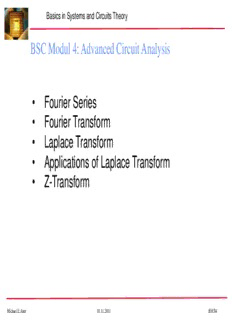
Fourier Series • Fourier Transform • Laplace Transform • Applications of Laplace Transform • Z ... PDF
Preview Fourier Series • Fourier Transform • Laplace Transform • Applications of Laplace Transform • Z ...
Basics in Systems and Circuits Theory BSC Modul 4: Advanced Circuit Analysis • Fourier Series • Fourier Transform • Laplace Transform • Applications of Laplace Transform • Z-Transform Michael E.Auer 01.11.2011 BSC04 Basics in Systems and Circuits Theory BSC Modul 4: Advanced Circuit Analysis • Fourier Series • Fourier Transform • Laplace Transform • Applications of Laplace Transform • Z-Transform Michael E.Auer 01.11.2011 BSC04 Basics in Systems and Circuits Theory Trigonometric Fourier Series (1) • The Fourier series of a periodic function f(t) is a representation that resolves f(t) into a dc component and an ac component comprising an infinite series of harmonic sinusoids. • Given a periodic function f(t) = f(t+nT) where n is an integer and T is the period of the function. ∞ ∑ f (t) = a + (a cos nωt + b sin nωt) 0 0 0 n 0 n=1 dc ac where ω =2π/T is called the fundamental frequency in 0 radians per second. Michael E.Auer 01.11.2011 BSC04 Basics in Systems and Circuits Theory Trigonometric Fourier Series (2) • and a and b are as follow n n 2 2 T T a = ∫ f (t)cos(nωt)dt b = ∫ f (t)sin(nωt)dt n o n o T 0 T 0 • in alternative form of f(t) ∞ ∑ f (t) = a + (c cos(nωt +φ ) 0 n 0 n n=1 dc ac b where c = a2 + b2 , φ = − tan−1( n ) (Inverse tangent or arctangent) n n n n a n Michael E.Auer 01.11.2011 BSC04 Basics in Systems and Circuits Theory Fourier Series Example Determine the Fourier series of the waveform shown right. Obtain the amplitude and phase spectra. 1, 0 < t <1 f (t) = and f (t) = f (t + 2) 0, 1< t < 2 2/nπ,n = odd a = 2 ∫T f (t)cos(nωt)dt = 0 and An = 0, n = even n 0 T 0 −90°,n = odd 2 T 2/nπ,n = odd φ = bn = T ∫0 f (t)sin(nω0t)dt = 0, n = even n 0, n = even ab)) APhmapslei tsupdeec t raunmd ∞ 1 2 1 ∑ f (t) = + sin(nπt), n = 2k −1 2 π n k=1 Truncating the series at N=11 Michael E.Auer 01.11.2011 BSC04 Basics in Systems and Circuits Theory Symmetry Considerations (1) Three types of symmetry 1. Even Symmetry : a function f(t) if its plot is symmetrical about the vertical axis. f (t) = f (−t) In this case, 2 T/2 a = ∫ f (t)dt 0 T 0 4 T/2 a = ∫ f (t)cos(nωt)dt n 0 T 0 b = 0 n Typical examples of even periodic function Michael E.Auer 01.11.2011 BSC04 Basics in Systems and Circuits Theory Symmetry Considerations (2) 2. Odd Symmetry : a function f(t) if its plot is anti-symmetrical about the vertical axis. f (−t) = − f (t) In this case, a = 0 0 4 T /2 b = ∫ f (t)sin(nωt)dt n 0 T 0 Typical examples of odd periodic function Michael E.Auer 01.11.2011 BSC04 Basics in Systems and Circuits Theory Symmetry Considerations (3) 3. Half-wave Symmetry : a function f(t) if a = 0 0 4 T/2 ∫ f (t)cos(nωt)dt , for n odd T a = 0 T 0 f (t − ) = − f (t) n 0 , for an even 2 4 T/2 ∫ f (t)sin(nωt)dt , for n odd b = 0 T 0 n 0 , for an even Typical examples of half-wave odd periodic functions Michael E.Auer 01.11.2011 BSC04 Basics in Systems and Circuits Theory Symmetry Considerations (4) Example 1 Find the Fourier series expansion of f(t) given below. 2 ∞ 1 nπ nπ ∑ Ans: f (t) = 1− cos sin t π n 2 2 n=1 Michael E.Auer 01.11.2011 BSC04 Basics in Systems and Circuits Theory Symmetry Considerations (5) Example 2 Determine the Fourier series for the half-wave cosine function as shown below. ∞ 1 4 1 ∑ Ans: f (t) = − cos nt, n = 2k −1 2 π2 n2 k=1 Michael E.Auer 01.11.2011 BSC04
Description: